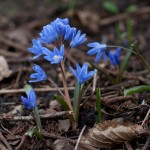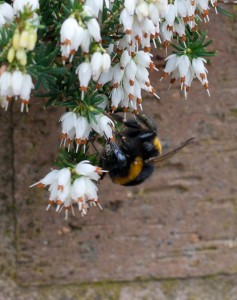I rarely visit Ryton gardens at this time of year because, well, to be frank, it is even less exciting than my own garden and much colder. However, I felt the need to go out with my camera and so I called in on my way home.
I have to admit, the drab and dreary weather (it started to rain whilst I was there) did not lessen the dull feel of the gardens, but, here or there were some hidden gems that made me think that underneath the mud and general brown tinge there was a whole host of life just waiting to get out.
 There were quite a few hellebores there, but many did not look their best – not sure if it was the early morning frost or if they just needed some TLC – however, not far away were some bright points of blue – I think they are scilla – there were not enough to cover the ground, but they still grabbed my attention.
There were quite a few hellebores there, but many did not look their best – not sure if it was the early morning frost or if they just needed some TLC – however, not far away were some bright points of blue – I think they are scilla – there were not enough to cover the ground, but they still grabbed my attention.
Whilst I didn’t see much in the way of edibles, the trees in the orchard were full of big, fat buds, and underneath they were planted with iris or daffodils. The daffodils were just showing some colour, in a couple of weeks they will be amazing.
One thing that I did notice was the amount of bird life there. They have put bird feeders in every garden. I am not sure if they have always done this, but there are never any out in the Summer. As a result, with every step, there was a flurry of activity as a chaffinch or blackbird or unidentifiable small bird zoomed off into the safety of the hedges. The lack of visitors at this time of year, and the mist and drizzle lent an air of tranquility to the place. The cacophony of bird song just added to this feeling. One bird that I used to hear a lot more around Daventry, before they built even more houses, was the yellowhammer, so I was very surprised that to find it in the middle of the gardens. I think it was just getting its voice back after the Winter, the song was almost there, but the characteristic wheeze at the end was much shortened.
 I always like the sensory garden at Ryton – whatever the time of year they always have something flowering, and this weekend was no exception – look at the little cyclamen that I found. I have planted corms several times in the garden, but whilst I seem to have one or two that will throw up some leaves, I never seem to get any flowers. (However, my anenome blanda – all of which seem to be blue – have just started to come into flower.)
I always like the sensory garden at Ryton – whatever the time of year they always have something flowering, and this weekend was no exception – look at the little cyclamen that I found. I have planted corms several times in the garden, but whilst I seem to have one or two that will throw up some leaves, I never seem to get any flowers. (However, my anenome blanda – all of which seem to be blue – have just started to come into flower.)
 My biggest surprise of the day also came in the sensory garden – my first bumblebee of the year, foraging on some heather. This will be a queen going out to gather food before the first of the brood start to hatch. It just shows the importance of having some early flowering plants in the garden – mahonia and some early flowering honeysuckles are also good for the early bees. Sorry for the poor quality picture though – I was taken a bit by surprise and she didn’t stay around for long!
My biggest surprise of the day also came in the sensory garden – my first bumblebee of the year, foraging on some heather. This will be a queen going out to gather food before the first of the brood start to hatch. It just shows the importance of having some early flowering plants in the garden – mahonia and some early flowering honeysuckles are also good for the early bees. Sorry for the poor quality picture though – I was taken a bit by surprise and she didn’t stay around for long!